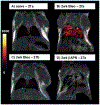Lysyl Oxidases as Targets for Cancer Therapy and Diagnostic Imaging
- PMID: 37565736
- PMCID: PMC12377064
- DOI: 10.1002/cmdc.202300331
Lysyl Oxidases as Targets for Cancer Therapy and Diagnostic Imaging
Abstract
The understanding of the contribution of the tumour microenvironment to cancer progression and metastasis, in particular the interplay between tumour cells, fibroblasts and the extracellular matrix has grown tremendously over the last years. Lysyl oxidases are increasingly recognised as key players in this context, in addition to their function as drivers of fibrotic diseases. These insights have considerably stimulated drug discovery efforts towards lysyl oxidases as targets over the last decade. This review article summarises the biochemical and structural properties of theses enzymes. Their involvement in tumour progression and metastasis is highlighted from a biochemical point of view, taking into consideration both the extracellular and intracellular action of lysyl oxidases. More recently reported inhibitor compounds are discussed with an emphasis on their discovery, structure-activity relationships and the results of their biological characterisation. Molecular probes developed for imaging of lysyl oxidase activity are reviewed from the perspective of their detection principles, performance and biomedical applications.
Keywords: enzyme inhibitors; extracellular matrix; posttranslational modification; quinoproteins; radiotracers.
© 2023 The Authors. ChemMedChem published by Wiley-VCH GmbH.
Conflict of interest statement
Conflict of Interests
The authors declare no conflict of interest.
Figures














Similar articles
-
Prescription of Controlled Substances: Benefits and Risks.2025 Jul 6. In: StatPearls [Internet]. Treasure Island (FL): StatPearls Publishing; 2025 Jan–. 2025 Jul 6. In: StatPearls [Internet]. Treasure Island (FL): StatPearls Publishing; 2025 Jan–. PMID: 30726003 Free Books & Documents.
-
The use of Open Dialogue in Trauma Informed Care services for mental health consumers and their family networks: A scoping review.J Psychiatr Ment Health Nurs. 2024 Aug;31(4):681-698. doi: 10.1111/jpm.13023. Epub 2024 Jan 17. J Psychiatr Ment Health Nurs. 2024. PMID: 38230967
-
Short-Term Memory Impairment.2024 Jun 8. In: StatPearls [Internet]. Treasure Island (FL): StatPearls Publishing; 2025 Jan–. 2024 Jun 8. In: StatPearls [Internet]. Treasure Island (FL): StatPearls Publishing; 2025 Jan–. PMID: 31424720 Free Books & Documents.
-
Extracellular Aldehyde Sensing Probes for In Vivo Imaging.Acc Chem Res. 2025 Jul 15;58(14):2203-2215. doi: 10.1021/acs.accounts.5c00200. Epub 2025 Jun 28. Acc Chem Res. 2025. PMID: 40580095
-
The Black Book of Psychotropic Dosing and Monitoring.Psychopharmacol Bull. 2024 Jul 8;54(3):8-59. Psychopharmacol Bull. 2024. PMID: 38993656 Free PMC article. Review.
Cited by
-
Insights into the molecular mechanisms underlying the function of lysyl oxidase like 1 in cancers.PeerJ. 2025 Aug 7;13:e19628. doi: 10.7717/peerj.19628. eCollection 2025. PeerJ. 2025. PMID: 40786111 Free PMC article. Review.
References
-
- Löser R, Habilitation thesis, Technische Universität Dresden (Germany), 2022. https://nbn-resolving.de/urn:nbn:de:bsz:14-qucosa2–840641.
-
- Csiszar K, Prog. Nucleic Acid Res. Mol. Biol 2001, 70, 1–32. - PubMed
Publication types
MeSH terms
Substances
Grants and funding
LinkOut - more resources
Full Text Sources
Medical

